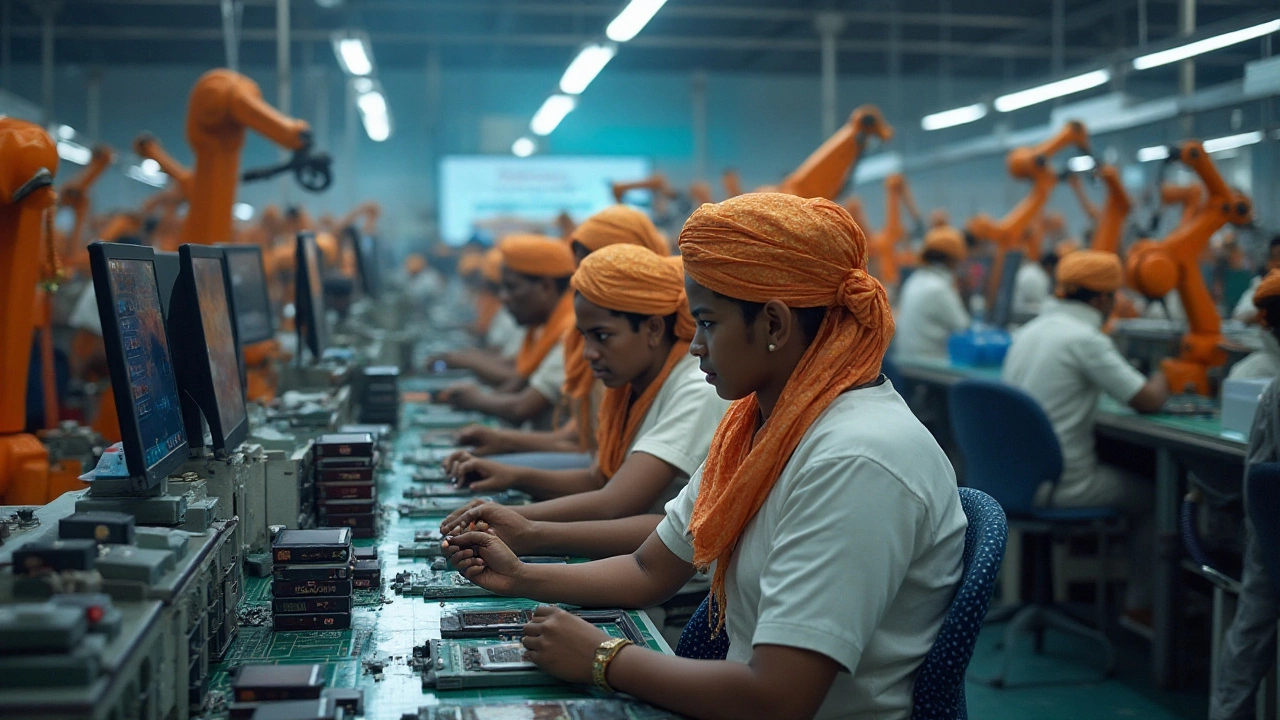Best Country for Electronics Manufacturing: Spotlight on India

When it comes to electronics manufacturing, choosing the right country can make or break your game plan. And guess what? India could very well be your golden ticket. With a booming tech scene, increasing investments, and a whole bunch of skilled folks ready to roll up their sleeves, India's making some serious waves.
You might be wondering, 'Why India?' Well, it's not just about the numbers; it's about the whole ecosystem. Imagine a country throwing open its doors with government initiatives, tax breaks, and huge investments in infrastructure—oh yeah, that's India alright.
If you're keen on cutting costs without cutting corners, India's got you covered. The cost of doing business here is pretty attractive when you compare it to other heavyweights like China or Vietnam. Plus, the government's 'Make in India' campaign is like a welcome mat for electronics manufacturers worldwide.
But hey, that's just a sneak peek. There's a lot more to uncover when it comes to understanding why India might just be the best bet for your electronics manufacturing ventures.
- India's Technological Edge
- Government Initiatives and Incentives
- Skilled Workforce
- Cost Advantages
- Infrastructure Developments
- The Global Impact
India's Technological Edge
India's spot in the electronics manufacturing realm isn't a coincidence—it's got a solid technological edge. Home to a massive pool of tech-savvy professionals, the country's no stranger to innovation. Think of all those Silicon Valley tech giants with Indian talent steering the ship. That talent is right here, ready to power your electronics dreams.
Remember the booming IT hubs like Bangalore and Hyderabad? These cities aren't just about software anymore. They've grown to be pivotal in electronics manufacturing too. Startups and tech giants alike find a natural habitat, combining creativity and collaboration to push innovation forward.
The academic scene here is bustling with top-tier engineering and tech schools. Institutes like IITs (Indian Institutes of Technology) churn out thousands of graduates each year, who are ready to contribute from day one. These institutes don't just produce quantity; they ensure quality, creating a workforce that knows the ins and outs of electronics.
| City | Main Technology Centers |
|---|---|
| Bangalore | Electronics, IT Services |
| Hyderabad | Telecom, Electronics |
| Delhi NCR | Infrastructure, IT Services |
Let's not forget about the country's push toward 5G and IoT. India's on the road to being a tech superpower, with significant investments funneled into these upcoming technologies. This means for electronics manufacturing, the scope is massive—from creating the hardware to the next-gen applications that run on them.
India's ecosystem encourages research and development too. A startup or a major corporation can find the right environment to innovate, test, and eventually, mass produce. With government-backed initiatives like 'Digital India', the landscape only keeps getting better. So, if you're eyeing a place where technology meets opportunity, India stands ready.
Government Initiatives and Incentives
India’s got some serious mojo going on when it comes to boosting its electronics manufacturing sector. The government isn’t just sitting around; it’s actively rolling out the red carpet for manufacturers. One of the biggest moves? The "Make in India" campaign. This initiative invites global businesses to come set up shop, offering all kinds of perks along the way. It’s like a big, friendly push in the right direction.
Then there’s the Production Linked Incentive (PLI) scheme. It’s all about giving monetary incentives to companies meeting certain production targets. Basically, the more you make and sell, the more you earn from the government. Sounds like a win-win, right?
But that’s not all. India’s Special Economic Zones (SEZs) offer really appealing tax breaks and regulatory perks for manufacturers. These zones are like exclusive clubs where the rules are made to encourage growth and attract big investments.
The government isn’t stopping at just tax benefits. It’s investing heavily in infrastructure too. Think about smoother roads, faster internet, and reliable power supplies. This makes the whole manufacturing process way more efficient and less of a headache.
Check out this quick rundown of some key government initiatives and incentives:
- Make in India: Aims to boost manufacturing across various sectors, including electronics, with various benefits.
- PLI Scheme: Offers cash incentives to boost domestic production and encourage exports.
- SEZs: Provide tax benefits and other incentives to promote industry growth.
- Skill India Initiative: Trains potential workers, ensuring a skilled workforce for industries.
And if you think this is just another government plan, you might be surprised. It’s already attracting big names in the electronics manufacturing game. Companies are hopping on board, setting up factories, and ramping up production quicker than you might expect. So, if you’re considering manufacturing in India, these initiatives can be a real game-changer for your business.
Skilled Workforce
When it comes to electronics manufacturing, having a skilled workforce isn't just a nice-to-have—it's essential. India is home to a massive pool of talented professionals who know their stuff inside and out. These folks aren't just making gadgets; they're innovating and pushing boundaries.
India churns out more engineers than most countries every year. Yeah, we're talking about over a million engineering graduates annually. Education hubs like IITs (Indian Institutes of Technology) are known for producing some of the sharpest minds in technology. And it's not just about young talent; there's a wealth of experienced professionals across varied sectors who have pivoted into electronics manufacturing.
Language? No problem! English is widely spoken here, making communication with international partners a breeze. This factor alone makes India a go-to place for companies that wish to branch out without the language barriers getting in the way. Plus, training programs tailored for electronics manufacturing continue to grow, ensuring that the workforce stays updated with the latest tech trends.
Let's look at some numbers to get a better picture:
| Year | Engineering Graduates (in millions) | Rank in English Proficiency |
|---|---|---|
| 2022 | 1.2 | 34th Globally |
| 2023 | 1.3 | 30th Globally |
Pretty impressive, right? It's not just about quantity; the quality is there too. Companies can tap into this talent pool, benefiting from fresh perspectives and innovative approaches.
So, if you're thinking of placing your bets on India for electronics manufacturing, you're not just getting workers; you're getting innovators with a finger on the pulse of the tech world.

Cost Advantages
Let's talk money—'cause we all know that's a big deal. When you think of electronics manufacturing, getting a tight grip on costs is crucial. This is where India truly shines. The cost of labor in India is significantly lower than in many other manufacturing countries. Yep, you heard it right. You can access a skilled workforce without burning through your budget.
Not just that, the sheer volume of tech-savvy talent means you’re getting quality labor at a fraction of the cost. It's a win-win! On top of that, setting up shop in India means you’ll benefit from reduced operational costs like utilities and logistics. It's cheaper to move things around, and you won’t find yourself overpaying for essentials.
Then there are the government's incentives and tax breaks under the 'Make in India' initiative, aimed squarely at reducing financial burdens for electronics manufacturing companies. They know what's up, and they're eager to attract global giants as well as innovative startups.
Another financial perk? With the market opening up, India has competitive pricing in raw materials. So, when you factor in both labor and material cost reductions, it's clear why more companies are calling India their second home.
For a clearer picture, consider this stat: labor costs in India can be as low as 20% of that in countries like the U.S. or Japan. A stronger dollar in global markets means you’re saving more by paying in rupees. This handy table might give you a snapshot:
| Country | Average Annual Wage per Worker (2023) |
|---|---|
| United States | $60,000 |
| China | $10,000 |
| India | $5,000 |
In the grand scheme of things, saving on costs doesn’t mean sacrificing quality—especially when India offers you good bang for your buck. So, think of India as your cost-efficient partner in the world of electronics.
Infrastructure Developments
Okay, so let's dig into how India is upping its game with infrastructure. You know those mega projects everyone's been buzzing about? They're real, and they’re a huge deal for electronics manufacturing. Take for instance the Delhi-Mumbai Industrial Corridor (DMIC)—it's not just a road; it's a lifeline for transporting goods quickly and efficiently across the country. Imagine cutting down on logistics hassles and watching your supply chain speed up.
And it's not just about building roads and ports. India's also expanding its power supply networks, which is crucial for keeping factories running smoothly—nobody wants unexpected power outages, right?
Check this out: the National Investment and Manufacturing Zones (NIMZs) are like mini-cities designed to support industries with world-class facilities and connectivity. There’s the Bengaluru-Bangalore-Chennai corridor and the Hyderabad Corridor that are turning into key hubs for tech and electronics companies. It’s like having a tailor-made business suit—but for your company.
Moreover, with the introduction of 5G networks, India's digital backbone is getting a serious upgrade. Better connectivity means faster communication between parts suppliers and manufacturers, which translates to more efficient production lines.
And let's not overlook the startups! There's a supportive vibe with tech parks popping up in cities like Pune and Hyderabad where fresh, innovative companies are setting their roots. These parks are built to foster a tech ecosystem with shared resources and facilities.
Efforts like these are making India not just a place with potential but a fully operational base where you can start producing electronics without second-guessing your infrastructure needs. So if you've been on the fence, these developments might just make you jump off and dive in.
The Global Impact
India's rise as a powerhouse in electronics manufacturing is not just boosting its own economy but shaking up the global market too. Why? Well, for starters, India offers a massive pool of tech talent, meaning companies around the world are getting access to not just any workforce, but a really smart one. This ups the quality of products being made
and positions India as a top competitor.
Now let's talk stats. Did you know that by 2022, India became one of the top five mobile phone manufacturers globally? No kidding! With giants like Foxconn and Pegatron setting up shop in India, it's safe to say India is not just a local player but a heavy hitter internationally. This influx of investment doesn’t just create jobs—it's also helping stabilize the electronics supply chain, crucial for keeping those gadgets coming without delays.
And it's not all about the big names. The cost advantages in India mean that startups and medium enterprises worldwide can also cash in on the action. What this means globally is a democratization of tech commodities. Products become cheaper, more folks have access to them, and innovations snowball from there.
Let's not forget the environmental angle. India's been making strides toward sustainable manufacturing practices. With renewable energy projects on the rise, more factories are pushing for a greener approach. While it takes the pressure off our planet, it also sets a standard for others to follow.
All said and done, India’s surge in the manufacturing industry isn’t just a win for the country; it’s a game changer worldwide. With its competitive edge and sustainable practices, India’s play is writing a new chapter in global electronics.





